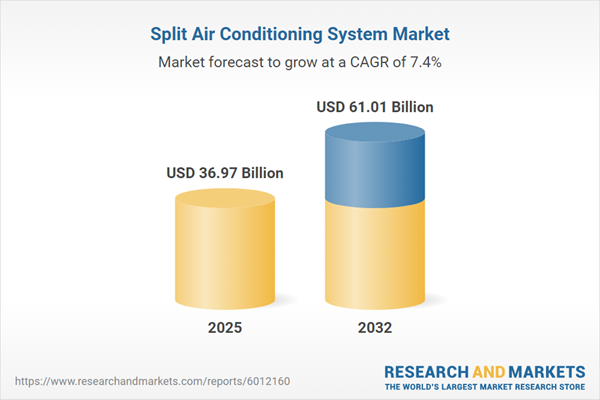Speak directly to the analyst to clarify any post sales queries you may have.
The split air conditioning system market is advancing as organizations prioritize environmentally responsible, efficient, and adaptive cooling solutions tailored to modern building requirements. Senior decision-makers are increasingly focused on regulatory alignment and operational efficiency to future-proof HVAC investments.
Market Snapshot: Split Air Conditioning System Market
Globally, the split air conditioning system market achieves steady annual growth, underpinned by widespread application in residential, commercial, and industrial sectors. Demand is fueled by the need for energy-efficient and resilient cooling systems that conform to stricter regulatory requirements. Increasing expectations for system durability and compliance shape the market landscape, sparking innovation in smart controls and environmentally friendly refrigerants. The primary keyword, split air conditioning system market, is central to ongoing product development, as manufacturers, suppliers, and facility operators optimize offerings to meet regional standards and distinct climate conditions. The evolution of efficiency benchmarks across geographies is driving continued adaptation and resilience in HVAC strategies.
Scope & Segmentation
- Compressor Types: Both fixed speed and inverter compressor technologies support diverse building portfolios by balancing precise energy management with operational flexibility for site-by-site needs.
- Capacity Ranges: Offering solutions below 2 tons, in the 2–5 ton category, and above 5 tons, the market enables tailored deployments suited for homes, large offices, and complex industrial environments alike.
- End User Segments: Residential, commercial, and industrial customers benefit from split system adaptability, which enhances cooling performance according to unique occupancy, spatial, and process requirements.
- Installation Methods: Businesses select between single split units for focused cooling and multi-split systems for scalable, zone-based climate control across adaptive floorplans.
- Distribution Channels: Offerings span physical retail locations, digital procurement platforms, and direct sales, allowing organizations to match supply strategies to their operational and logistical needs.
- Geographic Coverage: Solutions are implemented across North America, Latin America, Europe, Middle East & Africa, and Asia-Pacific, enabling regionally optimized installations and support for compliance programs specific to each market.
- Featured Technologies: Inverter drives, low global warming potential (GWP) refrigerants, IoT-based monitoring, integrated heat pumps, and advanced digital diagnostics combine to enhance system reliability, reduce environmental impact, and streamline maintenance.
- Company Coverage: Leading product innovation and market response are driven by Daikin Industries, Midea Group, Gree Electric Appliances, Mitsubishi Electric, LG Electronics, Panasonic Corporation, Samsung Electronics, Hitachi, Carrier Global, and Fujitsu General Limited.
Key Takeaways for Senior Decision-Makers
- Integrating advanced compressors and eco-friendly refrigerants positions organizations to support sustainability targets within evolving regulatory expectations.
- Utilizing automated controls and digital management systems increases energy optimization and streamlines multi-facility oversight in dynamic operational settings.
- Collaborating with established suppliers and aligning product selection to site-specific needs delivers tailored occupant comfort and adaptability as facility requirements change.
- Employing multiple sourcing options, such as digital procurement and retail channels, boosts procurement resilience against fluctuating supply market dynamics.
- Implementing predictive maintenance and real-time diagnostic features reduces operational downtime, providing better control over lifecycle costs for mission-critical facilities.
- Continually monitoring technological developments and adjusting to new policy trends enables proactive risk management and supports uninterrupted business performance.
Tariff Impact and Strategic Adaptation
Recent shifts in U.S. tariff policies require organizations to re-assess their approach to supplier relationships and inventory management. Expanding supplier networks, scenario-driven planning, and just-in-time inventory strategies can help businesses reduce procurement exposure and maintain operational flexibility in response to evolving regulatory scenarios.
Methodology & Data Sources
This assessment leverages in-depth desk research alongside structured interviews with supply chain decision-makers. Key insights were cross-validated using public databases and industry associations to provide senior leaders with robust, actionable analysis for operational planning.
Why This Report Matters
- Delivers strategic recommendations for executives addressing market transformation, new regulatory barriers, and technology opportunities in split air conditioning system adoption.
- Guides resource allocation and supplier engagement by highlighting adaptations necessary within tariff and procurement environments to enhance sourcing efficiency.
- Strengthens executive-level decision-making with comprehensive insights that improve operational resilience and foster long-term competitiveness.
Conclusion
Sustained success in the split air conditioning system market relies on regulatory vigilance, agile adoption of emerging technologies, and a clear focus on evolving facility needs. Strategic planning aligned to these priorities supports consistent performance and value creation across HVAC portfolios.
Additional Product Information:
- Purchase of this report includes 1 year online access with quarterly updates.
- This report can be updated on request. Please contact our Customer Experience team using the Ask a Question widget on our website.
Table of Contents
3. Executive Summary
4. Market Overview
7. Cumulative Impact of Artificial Intelligence 2025
Companies Mentioned
The companies profiled in this Split Air Conditioning System market report include:- Daikin Industries, Ltd.
- Midea Group Co., Ltd.
- Gree Electric Appliances, Inc. of Zhuhai
- Mitsubishi Electric Corporation
- LG Electronics Inc.
- Panasonic Corporation
- Samsung Electronics Co., Ltd.
- Hitachi, Ltd.
- Carrier Global Corporation
- Fujitsu General Limited
Table Information
| Report Attribute | Details |
|---|---|
| No. of Pages | 188 |
| Published | November 2025 |
| Forecast Period | 2025 - 2032 |
| Estimated Market Value ( USD | $ 36.97 Billion |
| Forecasted Market Value ( USD | $ 61.01 Billion |
| Compound Annual Growth Rate | 7.4% |
| Regions Covered | Global |
| No. of Companies Mentioned | 11 |









